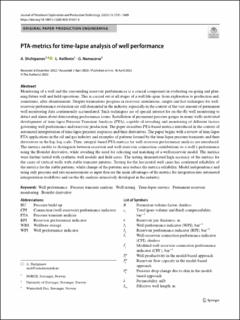| dc.contributor.author | Shchipanov, Anton | |
| dc.contributor.author | Kollbotn, Lars | |
| dc.contributor.author | Namazova, G. | |
| dc.date.accessioned | 2023-06-27T11:26:41Z | |
| dc.date.available | 2023-06-27T11:26:41Z | |
| dc.date.created | 2023-06-05T14:06:25Z | |
| dc.date.issued | 2023 | |
| dc.identifier.citation | Shchipanov, A., Kollbotn, L., & Namazova, G. (2023). PTA-metrics for time-lapse analysis of well performance. Journal of Petroleum Exploration and Production Technology, 13, 1591-1609. | en_US |
| dc.identifier.issn | 2190-0558 | |
| dc.identifier.uri | https://hdl.handle.net/11250/3073471 | |
| dc.description.abstract | Monitoring of a well and the surrounding reservoir performances is a crucial component in evaluating on-going and planning future well and field operations. This is carried out at all stages of a well life-span: from exploration to production and, sometimes, after abandonment. Despite tremendous progress in reservoir simulations, simple and fast techniques for well-reservoir performance evaluation are still demanded in the industry, especially in the context of the vast amount of permanent well monitoring data continuously accumulated. Such techniques are of special interest for on-the-fly well monitoring to detect and alarm about deteriorating performance issues. Installation of permanent pressure gauges in many wells motivated development of time-lapse Pressure Transient Analysis (PTA), capable of revealing and monitoring of different factors governing well performance and reservoir production. The paper describes PTA-based metrics introduced in the context of automated interpretation of time-lapse pressure responses and their derivatives. The paper begins with a review of time-lapse PTA applications in the oil and gas industry and examples of patterns formed by the time-lapse pressure transients and their derivatives in the log–log scale. Then, integral-based PTA-metrics for well-reservoir performance analysis are introduced. The metrics enable to distinguish between reservoir and well-reservoir connection contributions to a well’s performance using the Bourdet derivative, while avoiding the need for selecting and matching of a well-reservoir model. The metrics were further tested with synthetic well models and field cases. The testing demonstrated high accuracy of the metrics for the cases of vertical wells with stable transient patterns. Testing for the horizontal well cases has confirmed reliability of the metrics for the stable patterns, while change of the patterns may reduce the metrics reliability. Model independence and using only pressure and rate measurements as input data are the main advantages of the metrics for integration into automated interpretation workflows and on-the-fly analysis intensively developed in the industry. | en_US |
| dc.language.iso | eng | en_US |
| dc.publisher | Springer | en_US |
| dc.rights | Navngivelse 4.0 Internasjonal | * |
| dc.rights.uri | http://creativecommons.org/licenses/by/4.0/deed.no | * |
| dc.title | PTA-metrics for time-lapse analysis of well performance | en_US |
| dc.type | Peer reviewed | en_US |
| dc.type | Journal article | en_US |
| dc.description.version | publishedVersion | en_US |
| dc.rights.holder | The authors | en_US |
| dc.subject.nsi | VDP::Teknologi: 500 | en_US |
| dc.source.pagenumber | 1591-1609 | en_US |
| dc.source.volume | 13 | en_US |
| dc.source.journal | Journal of Petroleum Exploration and Production Technology | en_US |
| dc.identifier.doi | 10.1007/s13202-023-01631-4 | |
| dc.identifier.cristin | 2151923 | |
| cristin.ispublished | true | |
| cristin.fulltext | original | |
| cristin.qualitycode | 1 | |

